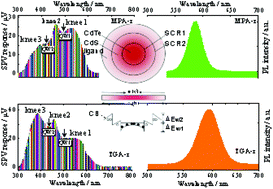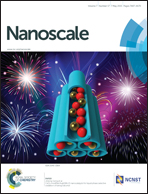Carrier transport in quantum dot quantum well microstructures of the self-assembled CdTe/CdS/ligand core–shell system†
Abstract
The study on the quantum dot quantum well (QDQW) microstructure modified by choosing different ligands containing a sulfhydryl group is of significance because it enables one to regulate photoexcited free charge carriers’ (FCCs’) transport behaviours in high-quality CdTe/ligand QDs via a self-assembled way. The photoelectron characteristics of ligand-capped CdTe nanoparticles were probed by a combination of surface photovoltaic (SPV) and photoacoustic technologies, supplemented by a computer simulation method of the CASTEP module. The experiment reveals that the D-value ΔEWi obtained by the associated two parameters of the SPV spectroscopy was closely related to the quantum confinement energy in the self-assembled CdTe/CdS/ligand core–shell system. In the paper the D-value was termed the depth of QWs, which were buried in the space charge regions located in the graded-band-gap and on either side of the shell-CdS. Obvious resonance quantum tunnelling may occur in the energy band structure with deep QWs on using certain ligands, resulting in an extended diffusion length of the FCCs on illumination of the photon energy hν ≥ Eg, core-CdTe, and in a strong SPV response at a specific wavelength region. In addition, the carrier–longitudinal optical phonon interaction is the reciprocal of the carriers’ lifetime. The d-frontier orbital in the graded-band-gap plays an important role in both the microstructure and the resonance quantum tunnelling of the QDQW system according to the CASTEP calculations.


 Please wait while we load your content...
Please wait while we load your content...